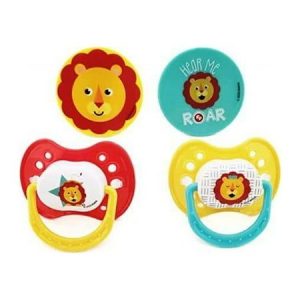Physical Address
304 North Cardinal St.
Dorchester Center, MA 02124
Physical Address
304 North Cardinal St.
Dorchester Center, MA 02124

Why does my baby not like pacifiers? Pacifiers are a popular tool for soothing and calming babies. However, not all babies take to them. If your little one isn’t interested in a pacifier, it can be frustrating. This article will explore reasons why your baby might reject a pacifier and offer tips for introducing one.
Newborns have a strong sucking reflex. This reflex is present even before birth and serves several purposes:
Sucking is essential for breastfeeding and bottle-feeding.
Sucking can be calming and provide comfort to babies.
Sucking on fingers or objects helps babies learn about the world around them.
Some babies find sucking on a pacifier to be a satisfying way to meet their sucking reflex needs.

There are several reasons why your baby might not be interested in a pacifier:
Timing is Key: If your baby is hungry or fussy, a pacifier might not be what they need at that moment. Try offering it when they are calm and content.
Not the Right Shape: Pacifiers come in various shapes and sizes. Experiment with different types to see if your baby prefers a particular nipple design.
Already Sucking on Something: If your baby is content sucking on their fingers or a toy, they might not be receptive to a pacifier.
Force Can Backfire: Pushing a pacifier into your baby’s mouth can create a negative association. Let them explore the pacifier at their own pace.
It’s important to be patient and persistent, but not forceful, when introducing a pacifier.

Here are some tips for introducing a pacifier to your baby:
Offer it after feedings: When your baby is full and content, they might be more open to trying a pacifier.
Warm it up (slightly): A slightly warm pacifier can mimic the feeling of a warm breast or bottle.
Dip it in breastmilk or formula (a little): The familiar taste might make the pacifier more appealing.
Let them explore it: Offer the pacifier to your baby and let them touch and mouth it on their own terms.
Be patient: It may take some time and practice for your baby to warm up to a pacifier.
If your baby consistently rejects a pacifier, don’t worry! There are other ways to soothe them.
Here are some alternative soothing techniques for your baby:
Skin-to-skin contact: Holding your baby close can provide warmth, comfort, and security.
Swaddling: A snug swaddle can mimic the feeling of being in the womb and promote calmness.
Shushing and rocking: The rhythmic sounds and motions of shushing and rocking can be very soothing for babies.
Singing or talking softly: The sound of your voice can be calming and comforting to your baby.
Warm bath: A warm bath can be a relaxing way to unwind your baby before bedtime.
Experiment with different soothing techniques to find what works best for your little one.

Not all babies take to pacifiers, and that’s okay! There are many other ways to soothe and comfort your little one. If you have any concerns about your baby’s feeding or soothing habits, talk to your pediatrician.
Remember, every baby is unique. Be patient, explore different options, and find what works best for you and your baby.
Pacifiers can be a helpful tool for soothing and calming some babies. However, not all babies take to them. If your little one isn’t interested in a pacifier, it can be frustrating. This article explores reasons why your baby might reject a pacifier and offers tips for introducing one.
Sucking on Hands or Toys: If your baby is content sucking on their fingers or a toy, they might not be interested in a pacifier. This doesn’t necessarily mean there’s a problem. Some babies find sucking on their hands or a familiar object to be comforting.
Developmental Stage: Younger babies may not have developed a strong sucking reflex yet. If your baby is very new, they might not be ready for a pacifier. You can always try introducing it again in a few weeks.
It’s important to be patient and observe your baby’s cues.

Even if your baby doesn’t take a pacifier, you can establish a calming bedtime routine. Here are some ideas:
Warm bath: A warm bath can be a relaxing way to unwind your baby before bedtime.
Dim lights and quiet time: Create a calm and quiet environment to signal to your baby that it’s time to wind down.
Singing or lullabies: The sound of your voice can be calming and comforting to your baby.
Gentle rocking or cuddling: Physical closeness can provide comfort and security.
A consistent bedtime routine can help your baby learn to expect and anticipate sleep, making bedtime smoother for everyone.
If you have any concerns about your baby’s feeding, sleeping, or soothing habits, talk to your doctor. They can provide guidance and address any underlying issues that might be affecting your baby’s comfort.
Remember, every baby is unique. There’s no one-size-fits-all approach to soothing. Be patient, explore different options, and find what works best for you and your baby.

Even if your baby doesn’t take a pacifier, you can establish a calming routine. Here are some ideas:
Warm bath: A warm bath can be a relaxing way to unwind your baby before bedtime.
Dim lights and quiet time: Create a calm and quiet environment to signal to your baby that it’s time to wind down.
Singing or lullabies: The sound of your voice can be calming and comforting to your baby.
Gentle rocking or cuddling: Physical closeness can provide comfort and security.
If you have any concerns about your baby’s feeding, sleeping, or soothing habits, talk to your doctor. They can provide guidance and address any underlying issues that might be affecting your baby’s comfort.
Remember, every baby is unique. There’s no one-size-fits-all approach to soothing. Be patient, explore different options, and find what works best for you and your baby.